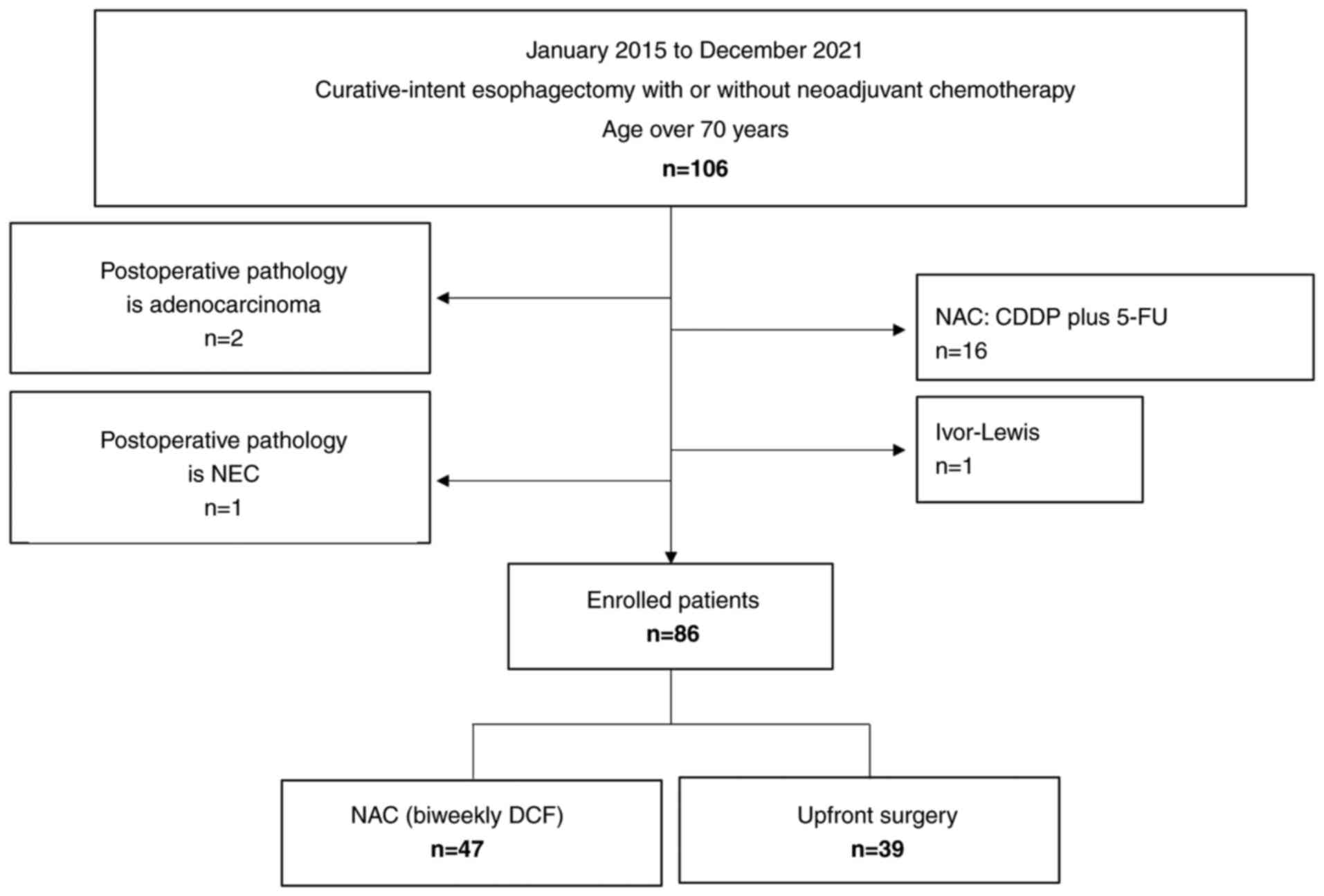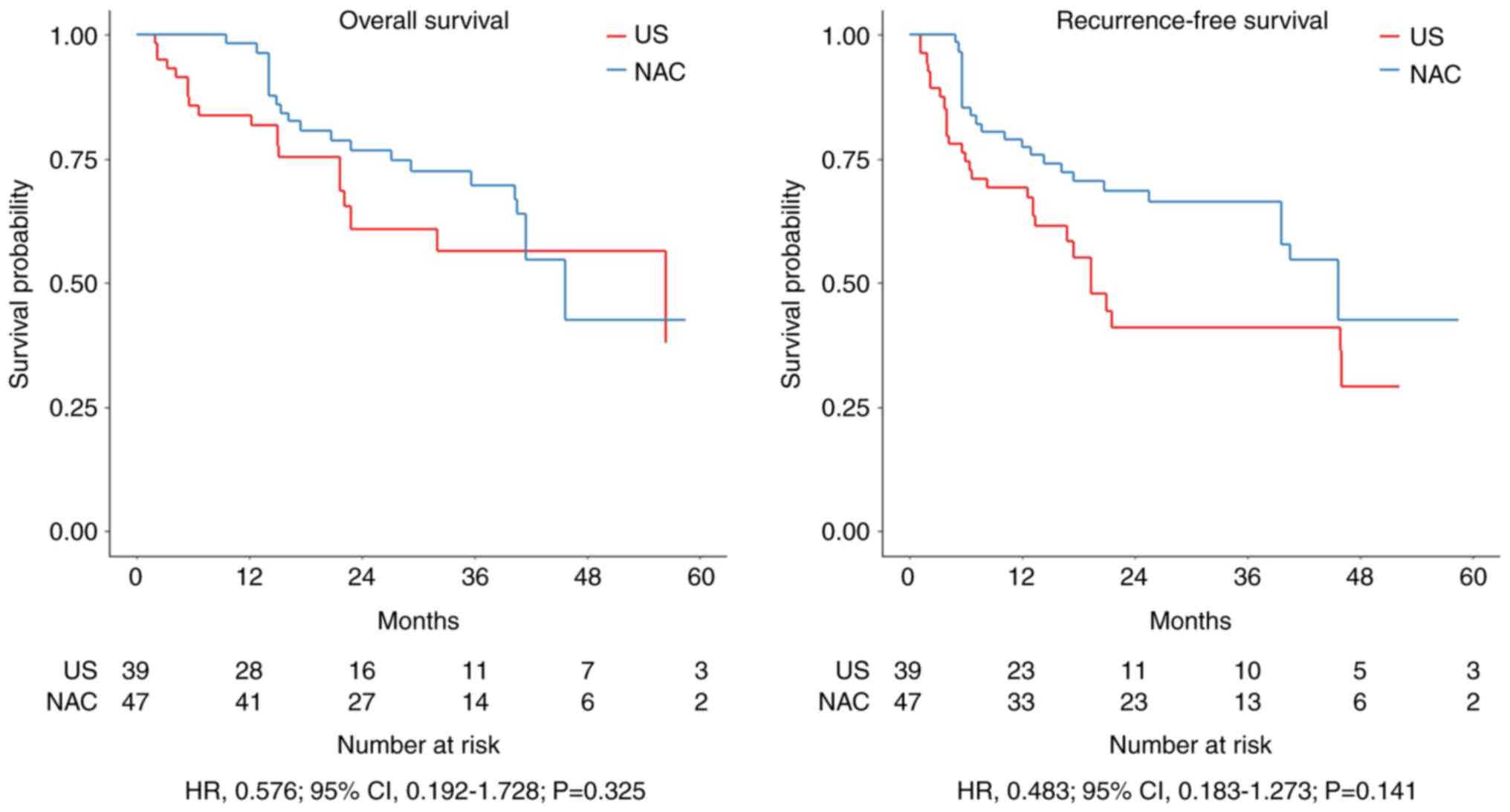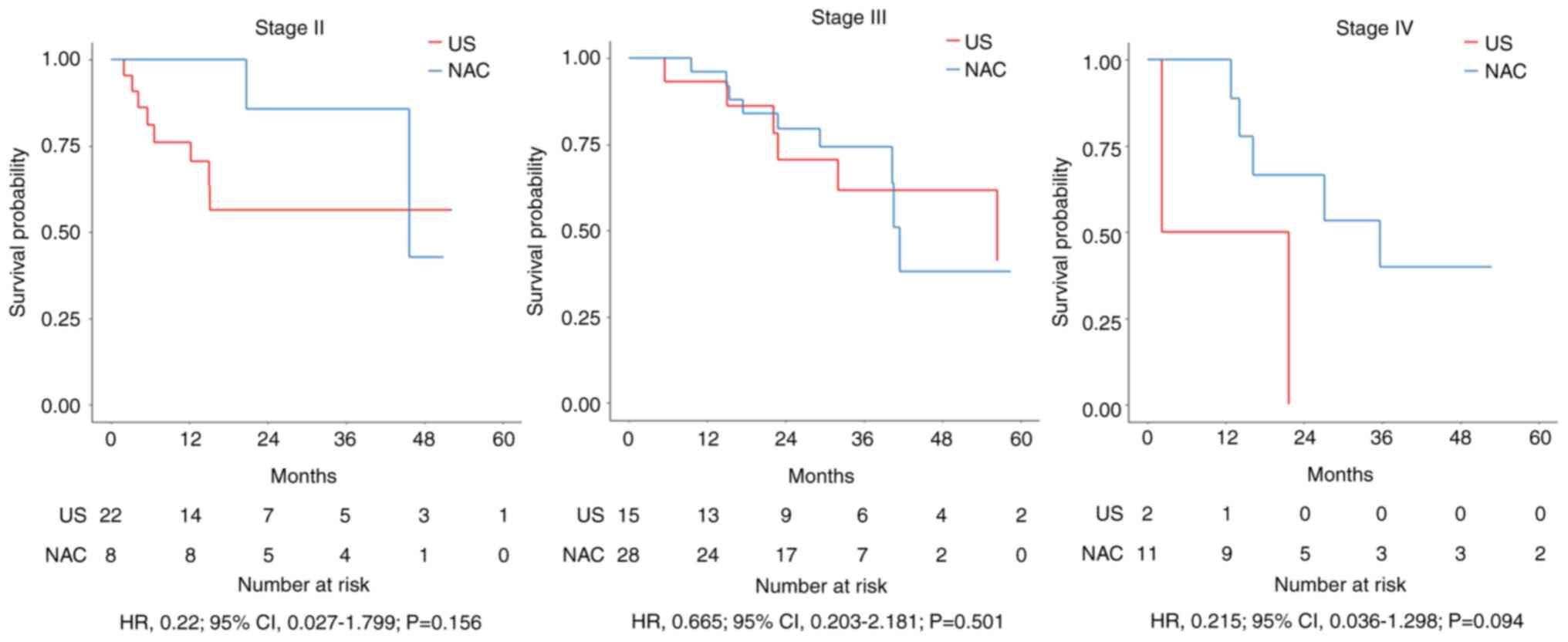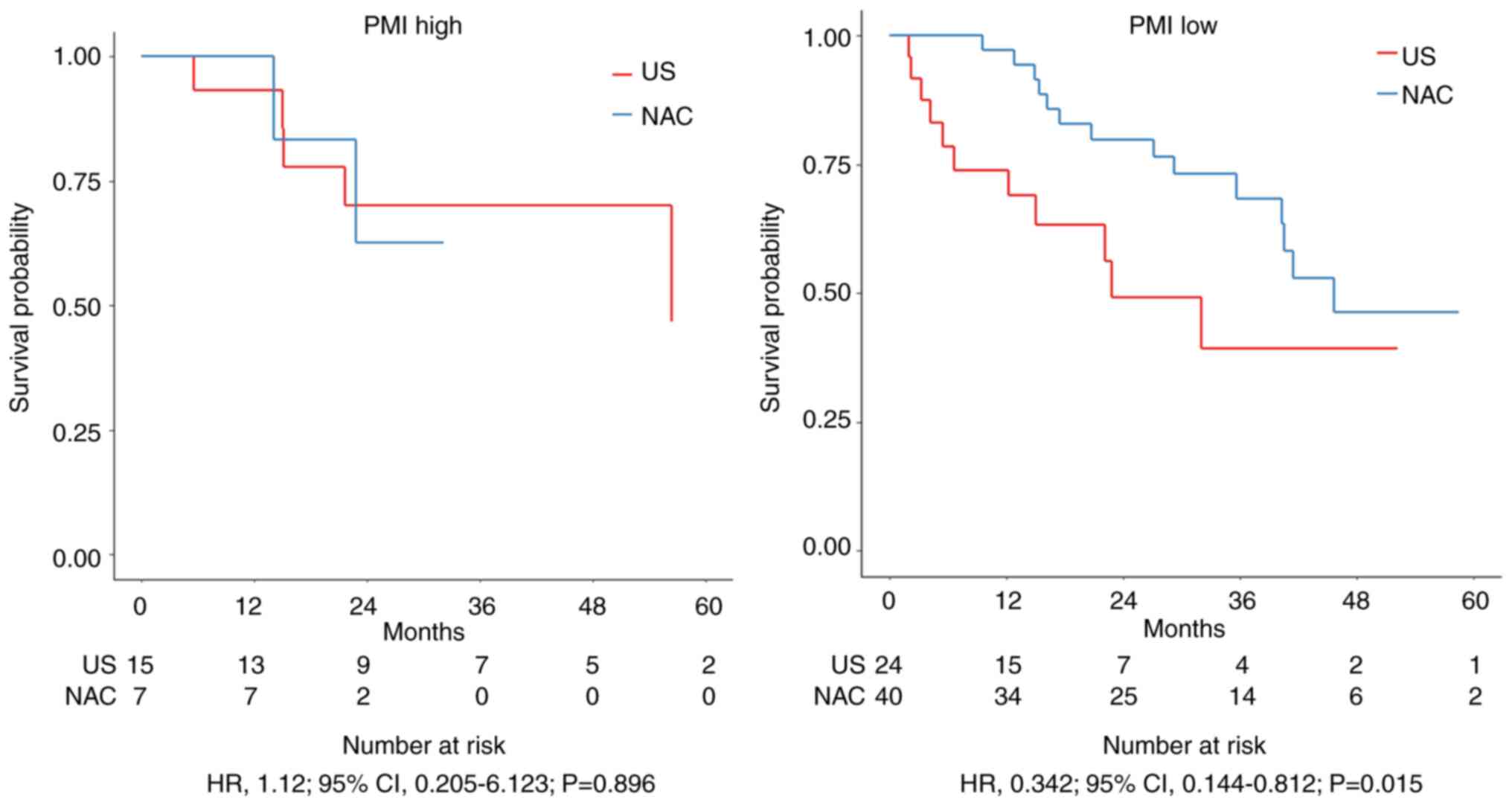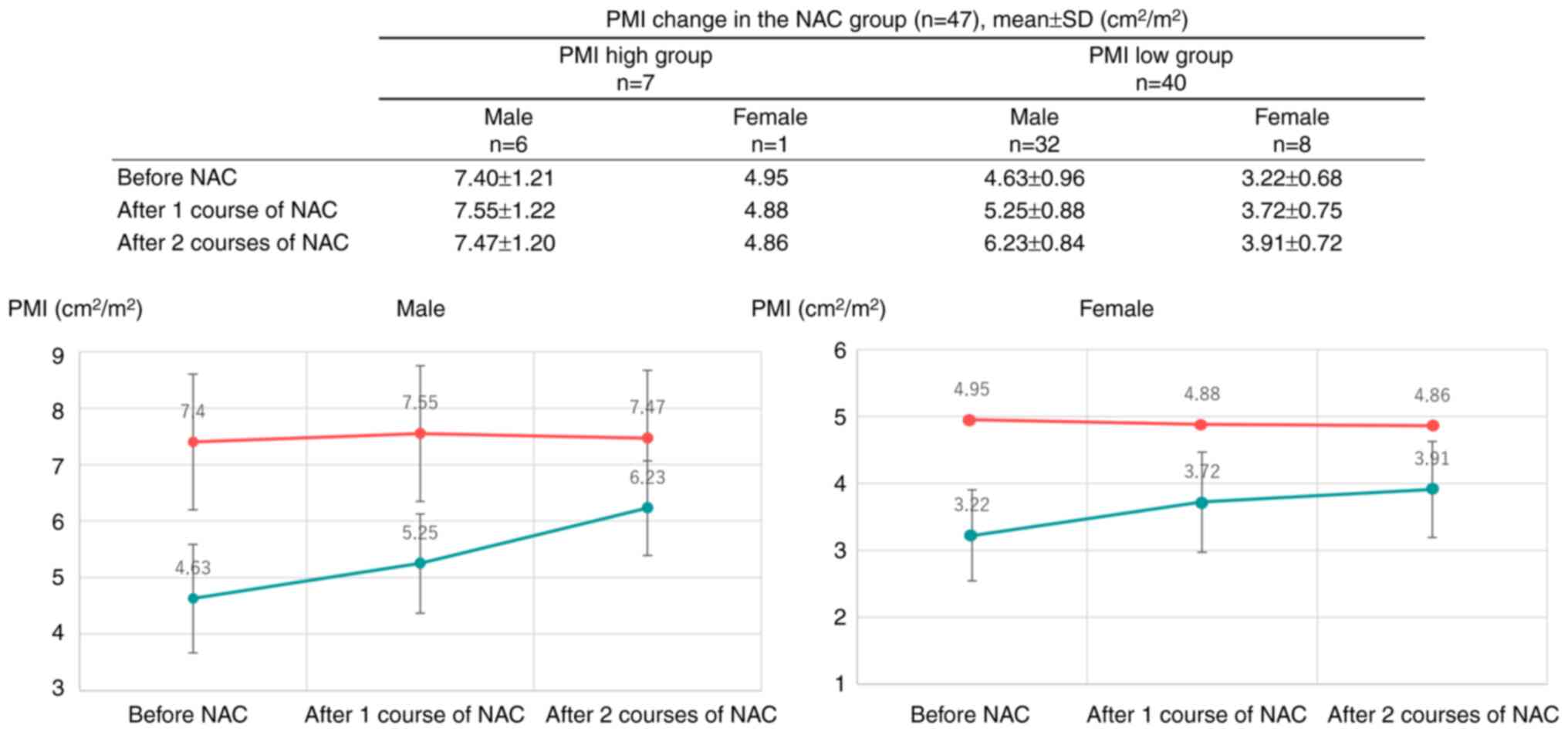Optimal treatment strategy for older patients with esophageal squamous cell carcinoma: A multicenter retrospective study
- Authors:
- Published online on: January 23, 2025 https://doi.org/10.3892/ol.2025.14905
- Article Number: 159
-
Copyright: © Sato et al. This is an open access article distributed under the terms of Creative Commons Attribution License.
Abstract
Introduction
Older adults more commonly suffer from esophageal squamous cell carcinoma (ESCC), and as populations age, the average age of those affected also increases (1). Comorbidities and critical dysfunction in pulmonary, cardiac, or renal organs, for example, are often present in older patients (2), who cannot tolerate treatment intensity as easily as younger patients. However, as the clinical data clearly show statistically, surgery alone cannot control advanced ESCC (3). In Japan, esophageal cancer in the surgically resectable stages is generally treated with neoadjuvant chemotherapy (NAC) and subsequent surgery (4,5). Recent results from the JCOG1109 randomized clinical study have changed the standard treatment for patients with clinical stage II or III ESCC in Japan. Now, neoadjuvant triplet chemotherapy with docetaxel, cisplatin, and 5-fluorouracil (DCF) is administered in place of cisplatin (CDDP) plus 5-fluorouracil (5-FU) (6,7). However, the JCOG1109 study included only patients aged ≤75 years with an Eastern Cooperative Oncology Group performance status (PS) of 0 or 1 (8). Deciding how to treat older patients based on clinical trial results from younger patients can be difficult in real-world clinical practice. By dividing the doses of docetaxel (TXT), CDDP, and 5-FU, new regimens with high completion rates and therapeutic efficacy are being developed (9–11). Identification of the increasing number of older patients with ESCC who are intolerant to preoperative treatment vs. those who should be treated preoperatively could speed the development of appropriate therapeutic strategies.
We therefore conducted a multicenter retrospective study to determine the indications for divided-dose DCF (biweekly DCF) in patients aged ≥70 years with ESCC in comparison to upfront surgery (US).
Patients and methods
Patient eligibility
Data were retrieved from a prospective database of patients who had undergone esophagectomy at Gifu University Hospital, Gifu Prefectural General Hospital, and Gifu Municipal Hospital. Eligibility criteria included subtotal esophagectomy performed for curative intent between January 2015 and December 2021; primary ESCC confirmed histologically; age ≥70 years; and clinical stage II/III disease as defined by the International Union Against Cancer TNM classification system, 8th edition (12), which includes clinical stage IV (no distant organ metastasis other than supraclavicular lymph node metastasis). Exclusion criteria were clinical T4 tumor, conversion to definitive chemoradiotherapy, and salvage surgery. Patients unable to undergo esophagectomy with no known reason for discontinuation were excluded. The eligible patients were divided into the NAC group and the US group for comparison of long-term outcomes. The Gifu University School of Medicine Ethics Committee and all participating centers approved the study protocol (ID: 2022-232).
Preoperative neoadjuvant chemotherapy and surgical treatment
The PS of all patients who underwent NAC (biweekly DCF) was 0–2. All had adequate bone marrow, liver, renal, and cardiovascular function. The anticancer drugs were TXT (35 mg/m2), CDDP (40 mg/m2), and 5-FU (400 mg/m2). TXT and CDDP were administered intravenously on days 1 and 15, and 5-FU was administered on days 1–5 and 15–19, with all patients scheduled for two cycles. Computed tomography (CT) or magnetic resonance imaging was used to evaluate all measurable lesions other than the primary tumor. Lesions were assessed with Response Evaluation Criteria in Solid Tumors Criteria version 1.1 (13). Four weeks following completion of the two chemotherapy cycles, response was confirmed by esophagogastroduodenoscopy and CT. Adverse events were defined according to the National Cancer Institute's Common Terminology Criteria for Adverse Events version 5.0.
In all patients, subtotal esophagectomy with mediastinal lymphadenectomy was performed via right thoracoscopy or thoracotomy. Follow-up included esophagogastroduodenoscopy and CT performed every 4–6 months each year postoperatively.
Endpoints
The primary endpoints were 3-year overall survival (OS) and recurrence-free survival (RFS). OS was calculated from the first examination day to the day of death or last follow-up day. RFS was calculated from the first examination day to the day of death, day of disease recurrence, or last follow-up day. At the last follow-up, patients were contacted to determine if they were still alive. The secondary endpoints were the between-group differences in perioperative complications, prognosis by pathological stage, and the difference in prognosis between patients with high and low psoas muscle index (PMI), a background factor assessed in older patients with ESCC who may derive greater benefit from this NAC regimen. As PMI may influence treatment effect (14,15), we classified patients into the PMI high group and PMI low group based on cut-off values of 6.36 cm2/m2 for males and 3.92 cm2/m2 for females (16), which indicate low skeletal muscle mass in Japan.
Statistical analysis
Patients' characteristics between the NAC and US groups are summarized by frequencies and percentages for categorical variables and by interquartile ranges for continuous variables. Between-group differences were compared with the chi-square test, Wilcoxon rank-sum test or Fisher's exact test. A logistic regression model estimated a propensity score representing the possibility of receiving NAC based on the patients' data at first examination. This model included the variables listed in Table I. Stabilized inverse probability weights were generated using the previously obtained propensity score. Kaplan-Meier curves adjusted by inverse probability weighting (IPW) were calculated to graphically compare OS and RFS between the NAC and US groups. The reported p-value was estimated using a Cox proportional hazards model. The hazard ratio (HR) was estimated by Cox IPW regression. Robust variance was used to avoid underestimating the variance of the regression coefficients. Subgroup analysis based on pathological stage and PMI was performed in the unweighted population.
Adverse events in the NAC group are summarized by frequencies and percentages. Surgical results are summarized by frequencies and percentages for the categorical variables and medians with interquartile ranges for the continuous variables. Between-group differences were estimated by Fisher's exact test or Wilcoxon rank-sum test. All P-values were two-sided, with the level of significance set at P<0.05. All analyses were performed with R 4.2.2 (The R Project for Statistical Computing).
Results
Patients and inverse probability weighting analysis
This study included 86 eligible patients (Fig. 1). Table I summarizes the patient background characteristics of the NAC group (n=47 patients, 54.7%) and US group (n=39 patients, 44.2%). Overall median patient age was 75.5 (71–79) years. PS was significantly better and clinical stage disease was significantly more advanced in the NAC group vs. US group. Patient characteristics in both groups were similar following IPW (Table II), and no characteristics were significantly different. Postoperative adjuvant chemotherapy was added for 18.4% of the patients in the US group.
Table II.Patient clinical and background characteristics after inverse probability weighting, where the information of each patient is weighted by their stabilized inverse probability. |
Patient outcomes and survival
Kaplan-Meier survival curves for OS and RFS in the IPW cohort are shown in Fig. 2. Prognosis was not significantly different between the NAC group and US group (3-year OS: HR=0.576; P=0.325 and 3-year RFS: HR=0.483; P=0.141). The incidence of adverse events of Grade 3 or higher in the NAC group was 20 (42.6%) for hematologic toxicity and 9 (19.1%) for non-hematologic toxicity (Table III). In the NAC group, 32 patients (68.1%) underwent thoracoscopic surgery, and 15 patients (31.9%) underwent open thoracotomy, whereas in the US group, the numbers were 29 patients (74.4%) and 10 patients (25.6%), respectively. Operative time, amount of blood loss, and postoperative complications can be compared between the two groups in Table IV. In both groups, pneumonia occurred in about 20% and recurrent nerve palsy in about 10% of the patients, but the differences were non-significant. However, anastomotic leakage was significantly more common in the US group. We compared OS by pathological stage between the NAC and US groups but observed no significant difference for any stage (3-year OS for stages II, III, and IV: P=0.156, P=0.501, and P=0.094, respectively) (Fig. 3). There were 22 patients (25.6%) in the PMI high group and 64 patients (74.4%) in the PMI low group. No significant difference in 3-year OS was found in the PMI high group (HR=1.12; 95% confidence interval [CI], 0.205–6.123; P=0.896), but in the PMI low group, it was significantly prolonged in the NAC group compared to the US group (HR=0.342; 95% CI, 0.144–0.812; P=0.015) (Fig. 4).
Discussion
Surgery is a particularly invasive treatment for ESCC. Nevertheless, it has remained the primary form of treatment for locally advanced ESCC even though perioperative treatment has intensified and improved the prognosis. Recent advances have increased the safety of surgical treatment, and more facilities are actively performing surgery on older patients with ESCC (17). In a study comparing 50 esophageal cancer patients ≥75 years old with 100 patients <75 years old, Kanda et al (18) reported no significant differences in postoperative complications. Morita et al (19) reported a morbidity rate of 25% for esophagectomy in patients ≥80 years old and found the incidences of surgical and medical complications to be similar to those for patients <70 years old. Moreover, they reported a decreased morbidity rate even in their patients >80 years old by following strict indications for surgery and performing a less invasive operation (omitting supraclavicular lymphadenectomy and performing a two-stage operation for risky patients). In their study of 5,066 patients aged 75–79 years old with ESCC, Motoyama et al (20) reported that surgery significantly prolonged OS compared to chemoradiation therapy or chemotherapy alone in advanced esophageal cancer of stage II or higher. In contrast, Miyata et al (21) reported that among 722 esophageal cancer patients >70 years old divided into four groups according to age, respiratory and cardiac complications increased with age. Older patients are particularly faced with many age-specific problems, such as aspiration pneumonia from delayed recovery of swallowing function, prolonged hospitalization due to decreased activities of daily living, and even progression of dementia.
There are several reports on the benefits of NAC to treat esophageal cancer in older patients. Yamashita et al (22) compared data on patients aged ≥75 years with advanced ESCC receiving NAC or not and found a better prognosis in those patients responding pathologically to NAC. However, in their patients with a PS of 1 or higher, the prognostic value of NAC was not clear, and they suggested that this group could likely undergo surgery alone. Among older patients with ESCC and a poor PS, Booka et al (23) found NAC to be non-beneficial and considered an increase in postoperative complications as the reason for NAC worsening the prognosis of these patients. Matsuda et al (24) similarly reported no survival benefit with preoperative DCF, the current standard of treatment, in patients >76 years old. Furthermore, they reported that pneumonia and anastomotic leakage as postoperative complications were negative prognostic factors for shorter OS and RFS in patients with esophageal cancer who were >75 years old and had undergone preoperative therapy with DCF (25).
Myelosuppression may be reduced by the divided administration of TXT and CDDP without greatly changing its efficacy (10). Neutropenia was the most common Grade 3 or higher toxicity in 31.3% of the patients in the biweekly treatment regimen, whereas Kato et al (7) reported that 85% of their patients developed Grade 3 or higher neutropenia. In the present study, we limited the NAC regimen to biweekly DCF. Although this regimen was reported to be a less toxic and potentially effective treatment, it did not show usefulness as NAC in an older population (9,10). This result is similar to and supports that reported in the previous literature (22,23,25). Although there is no difference in long-term prognosis, it may be better for older patients with ESCC to undergo US to avoid the side effects and decreased physical strength resulting from NAC. In our examination of surgical outcomes, the incidence of failure resulting in anastomotic leakage was different between the NAC group and US group. This was presumably due to differences in fine anastomotic technique and gastric tube construction between centers.
In NAC for ESCC, the PMI has a significant effect on differences in chemotherapy response rates and adverse event rates (11,14,26,27). Our cohort showed significantly prolonged 3-year OS in the PMI low group of the NAC group compared to that in the US group. The usual duration of NAC of eight weeks or more is an active period of nutritional management and intervention with rehabilitation. The present results suggest that for older patients with ESCC and low PMI, the duration of NAC may also lead to a period of careful preoperative preparation, which may result in a favorable outcome by selecting eligible patients for surgery. In fact, the PMI low group tended to have higher PMI due to multifaceted therapeutic interventions during the NAC (Fig. 5). However, as low PMI itself is a favorable factor for adverse events, it is important to perform NAC safely and in conjunction with the delivery of adequate nutritional therapy and rehabilitation that maintains muscle mass. It is possible that the positive impact of lower toxicity by dividing DCF into a biweekly regimen had an oncological effect in the low PMI group.
This study has several limitations. First, selection bias was likely present due to the retrospective nature of the study. Second, although this study focused only on a treatment regimen of biweekly DCF, dose intensities were not analyzed. Further, patients unable to undergo esophagectomy with no known reason for discontinuation, such as disease progression or toxicity during NAC, were excluded. Third, limited information was collected about patient characteristics, and preoperative pulmonary function or other factors were not evaluated. No power calculations were performed in the PMI study because recruitment was opportunistic. Fourth, consensus on the indications for postoperative adjuvant therapy in the US group was lacking. Fifth, there was a relatively short observation period.
We found that compared to US, a biweekly DCF treatment regimen did not prolong OS and RFS at all stages in patients with advanced ESCC who were ≥70 years old. Further prospective large-scale studies will be required to develop an optimal treatment strategy that is less toxic to but maintains efficacy in older patients with advanced ESCC.
Acknowledgements
Not applicable.
Funding
Funding: No funding was received.
Availability of data and materials
The data generated in the present study may be requested from the corresponding author.
Authors' contributions
YS, YT, RT, TS, RA, TI, MY, NN, DW and NM contributed to study conception and design. Material preparation, data collection and analysis were performed by YS, YT, RT, TS, RA, TI and DW, and MY, NN and NM provided academic advice. YS wrote the first draft of the manuscript, and all authors commented on previous versions of the manuscript. YS and NM confirm the authenticity of all the raw data. All authors have read and approved the final manuscript.
Ethics approval and consent to participate
The present study was approved by the Gifu University School of Medicine Ethics Committee (ID: 2022-232; Gifu, Japan). Informed consent was obtained in writing from all individual participants included in the study.
Patient consent for publication
Written informed consent was obtained from the patients for publication of this original article and accompanying images.
Competing interests
The authors declare that they have no competing interests.
Glossary
Abbreviations
Abbreviations:
|
ESCC |
esophageal squamous cell carcinoma |
|
NAC |
neoadjuvant chemotherapy |
|
DCF |
docetaxel, cisplatin, 5-fluorouracil |
|
PS |
performance status |
|
TXT |
docetaxel |
|
CDDP |
cisplatin |
|
5-FU |
5-fluorouracil |
|
US |
upfront surgery |
|
CT |
computed tomography |
|
OS |
overall survival |
|
RFS |
recurrence-free survival |
|
PMI |
psoas muscle index |
|
IPW |
inverse probability weighting |
|
HR |
hazard ratio |
References
|
Watanabe M, Toh Y, Ishihara R, Kono K, Matsubara H, Miyazaki T, Morita M, Murakami K, Muro K, Numasaki H, et al: Comprehensive registry of esophageal cancer in Japan, 2015. Esophagus. 20:1–28. 2023. View Article : Google Scholar : PubMed/NCBI | |
|
Oguma J, Ozawa S, Ishiyama K and Daiko H: Clinical significance of sarcopenic dysphagia for patients with esophageal cancer undergoing esophagectomy: A review. Ann Gastroenterol Surg. 6:738–745. 2022. View Article : Google Scholar : PubMed/NCBI | |
|
Ando N, Iizuka T, Ide H, Ishida K, Shinoda M, Nishimaki T, Takiyama W, Watanabe H, Isono K, Aoyama N, et al: Surgery plus chemotherapy compared with surgery alone for localized squamous cell carcinoma of the thoracic esophagus: A Japan Clinical Oncology Group Study-JCOG9204. J Clin Oncol. 21:4592–4596. 2003. View Article : Google Scholar : PubMed/NCBI | |
|
Kitagawa Y, Ishihara R, Ishikawa H, Ito Y, Oyama T, Oyama T, Kato K, Kato H, Kawakubo H, Kawachi H, et al: Esophageal cancer practice guidelines 2022 edited by the Japan esophageal society: Part 1. Esophagus. 20:343–372. 2023. View Article : Google Scholar : PubMed/NCBI | |
|
Kitagawa Y, Ishihara R, Ishikawa H, Ito Y, Oyama T, Oyama T, Kato K, Kato H, Kawakubo H, Kawachi H, et al: Esophageal cancer practice guidelines 2022 edited by the Japan Esophageal Society: Part 2. Esophagus. 20:373–389. 2023. View Article : Google Scholar : PubMed/NCBI | |
|
Nakamura K, Kato K, Igaki H, Ito Y, Mizusawa J, Ando N, Udagawa H, Tsubosa Y, Daiko H, Hironaka S, et al: Three-arm phase III trial comparing cisplatin plus 5-FU (CF) versus docetaxel, cisplatin plus 5-FU (DCF) versus radiotherapy with CF (CF-RT) as preoperative therapy for locally advanced esophageal cancer (JCOG1109, NExT study). Jpn J Clin Oncol. 43:752–755. 2013. View Article : Google Scholar : PubMed/NCBI | |
|
Kato K, Machida R, Ito Y, Daiko H, Ozawa S, Ogata T, Hara H, Kojima T, Abe T, Bamba T, et al: Doublet chemotherapy, triplet chemotherapy, or doublet chemotherapy combined with radiotherapy as neoadjuvant treatment for locally advanced oesophageal cancer (JCOG1109 NExT): A randomised, controlled, open-label, phase 3 trial. Lancet. 404:55–66. 2024. View Article : Google Scholar : PubMed/NCBI | |
|
Oken MM, Creech RH, Tormey DC, Horton J, Davis TE, McFadden ET and Carbone PP: Toxicity and response criteria of the Eastern Cooperative Oncology Group. Am J Clin Oncol. 5:649–655. 1982. View Article : Google Scholar : PubMed/NCBI | |
|
Tanaka Y, Yoshida K, Sanada Y, Osada S, Yamaguchi K and Takahashi T: Biweekly docetaxel, cisplatin, and 5-fluorouracil (DCF) chemotherapy for advanced esophageal squamous cell carcinoma: A phase I dose-escalation study. Cancer Chemother Pharmacol. 66:1159–1165. 2010. View Article : Google Scholar : PubMed/NCBI | |
|
Tanaka Y, Yoshida K, Yamada A, Tanahashi T, Okumura N, Matsuhashi N, Yamaguchi K and Miyazaki T: Phase II trial of biweekly docetaxel, cisplatin, and 5-fluorouracil chemotherapy for advanced esophageal squamous cell carcinoma. Cancer Chemother Pharmacol. 77:1143–1152. 2016. View Article : Google Scholar : PubMed/NCBI | |
|
Sato Y, Tanaka Y, Imai T, Okumura N, Matsuhashi N, Takahashi T, Shimokawa T and Yoshida K: Serum diamine oxidase activity derived from response to chemotherapy affects adverse events and serum amino acid levels. Support Care Cancer. 30:9369–9377. 2022. View Article : Google Scholar : PubMed/NCBI | |
|
Brierley JD, Gospodarowicz MK and Wittekind C: TNM Classification of Malignant Tumours. 8th edition. Wiley-Blackwell; Hoboken, NJ: 2016 | |
|
Eisenhauer EA, Therasse P, Bogaerts J, Schwartz LH, Sargent D, Ford R, Dancey J, Arbuck S, Gwyther S, Mooney M, et al: New response evaluation criteria in solid tumours: revised RECIST guideline (version 1.1). Eur J Cancer. 45:228–247. 2009. View Article : Google Scholar : PubMed/NCBI | |
|
Sato Y, Tanaka Y, Imai T, Ojio H, Mase J, Hatanaka Y, Suetsugu T, Fujii H, Okumura N, Matsuhashi N, et al: Effect of biweekly-DCF neoadjuvant chemotherapy on skeletal muscle mass of esophageal cancer patients. Gan To Kagaku Ryoho. 49:47–52. 2022.(Japanese). PubMed/NCBI | |
|
Kaido T, Ogawa K, Fujimoto Y, Ogura Y, Hata K, Ito T, Tomiyama K, Yagi S, Mori A and Uemoto S: Impact of sarcopenia on survival in patients undergoing living donor liver transplantation. Am J Transplant. 13:1549–1556. 2013. View Article : Google Scholar : PubMed/NCBI | |
|
Hamaguchi Y, Kaido T, Okumura S, Kobayashi A, Shirai H, Yao S, Yagi S, Kamo N, Okajima H and Uemoto S: Proposal for new selection criteria considering pre-transplant muscularity and visceral adiposity in living donor liver transplantation. J Cachexia Sarcopenia Muscle. 9:246–254. 2018. View Article : Google Scholar : PubMed/NCBI | |
|
Hamamoto Y, Akutsu Y, Nagashima F, Hironaka S, Ito Y, Kato K, Hara H, Tsubosa Y, Nakagawa S, Daiko H, et al: Multicenter questionnaire survey on patterns of care for elderly patients with esophageal squamous cell carcinoma by the Japan Esophageal Oncology Group. Jpn J Clin Oncol. 46:111–115. 2016.PubMed/NCBI | |
|
Kanda M, Koike M, Tanaka C, Kobayashi D, Hayashi M, Yamada S, Nakayama G, Omae K and Kodera Y: Feasibility of subtotal esophagectomy with systematic lymphadenectomy in selected elderly patients with esophageal cancer; a propensity score matching analysis. BMC Surg. 19:1432019. View Article : Google Scholar : PubMed/NCBI | |
|
Morita M, Egashira A, Yoshida R, Ikeda K, Ohgaki K, Shibahara K, Oki E, Sadanaga N, Kakeji Y and Maehara Y: Esophagectomy in patients 80 years of age and older with carcinoma of the thoracic esophagus. J Gastroenterol. 43:345–351. 2008. View Article : Google Scholar : PubMed/NCBI | |
|
Motoyama S, Maeda E, Iijima K, Sato Y, Koizumi S, Wakita A, Nagaki Y, Fujita H, Yoneya T, Imai K, et al: Does esophagectomy provide a survival advantage to patients aged 80 years or older? Analyzing 5066 patients in the National Database of Hospital-based Cancer Registries in Japan. Ann Surg. 276:e16–e23. 2022. View Article : Google Scholar : PubMed/NCBI | |
|
Miyata H, Yamasaki M, Makino T, Miyazaki Y, Takahashi T, Kurokawa Y, Nakajima K, Takiguchi S, Mori M and Doki Y: Clinical outcome of esophagectomy in elderly patients with and without neoadjuvant therapy for thoracic esophageal cancer. Ann Surg Oncol. 22 (Suppl 3):S794–S801. 2015. View Article : Google Scholar : PubMed/NCBI | |
|
Yamashita K, Momose K, Tanaka K, Makino T, Saito T, Yamamoto K, Takahashi T, Kurokawa Y, Nakajima K, Eguchi H and Doki Y: Indications for neoadjuvant chemotherapy in older patients undergoing esophagectomy for esophageal cancer. Surg Today. 54:442–451. 2024. View Article : Google Scholar : PubMed/NCBI | |
|
Booka E, Haneda R, Ishii K, Tsushima T, Yasui H and Tsubosa Y: The negative impact of preoperative chemotherapy on survival after esophagectomy for vulnerable elderly patients with esophageal cancer. Ann Surg Oncol. 28:1786–1795. 2021. View Article : Google Scholar : PubMed/NCBI | |
|
Matsuda S, Kitagawa Y, Takemura R, Okui J, Okamura A, Kawakubo H, Muto M, Kakeji Y, Takeuchi H, Watanabe M and Doki Y: Real-world evaluation of the efficacy of neoadjuvant DCF over CF in esophageal squamous cell carcinoma: Propensity score-matched analysis from 85 authorized institutes for esophageal cancer in Japan. Ann Surg. 278:e35–e42. 2023. View Article : Google Scholar : PubMed/NCBI | |
|
Matsuda S, Kitagawa Y, Okui J, Okamura A, Kawakubo H, Takemura R, Muto M, Kakeji Y, Takeuchi H, Watanabe M and Doki Y: Old age and intense chemotherapy exacerbate negative prognostic impact of postoperative complication on survival in patients with esophageal cancer who received neoadjuvant therapy: A nationwide study from 85 Japanese esophageal centers. Esophagus. 20:445–454. 2023. View Article : Google Scholar : PubMed/NCBI | |
|
Tanaka Y, Ueno T, Yoshida N, Akutsu Y, Takeuchi H, Baba H, Matsubara H, Kitagawa Y and Yoshida K: The effect of an elemental diet on oral mucositis of esophageal cancer patients treated with DCF chemotherapy: A multi-center prospective feasibility study (EPOC study). Esophagus. 15:239–248. 2018. View Article : Google Scholar : PubMed/NCBI | |
|
Tanaka Y, Shimokawa T, Harada K and Yoshida K: Effectiveness of elemental diets to prevent oral mucositis associated with cancer therapy: A meta-analysis. Clin Nutr ESPEN. 49:172–180. 2022. View Article : Google Scholar : PubMed/NCBI |



